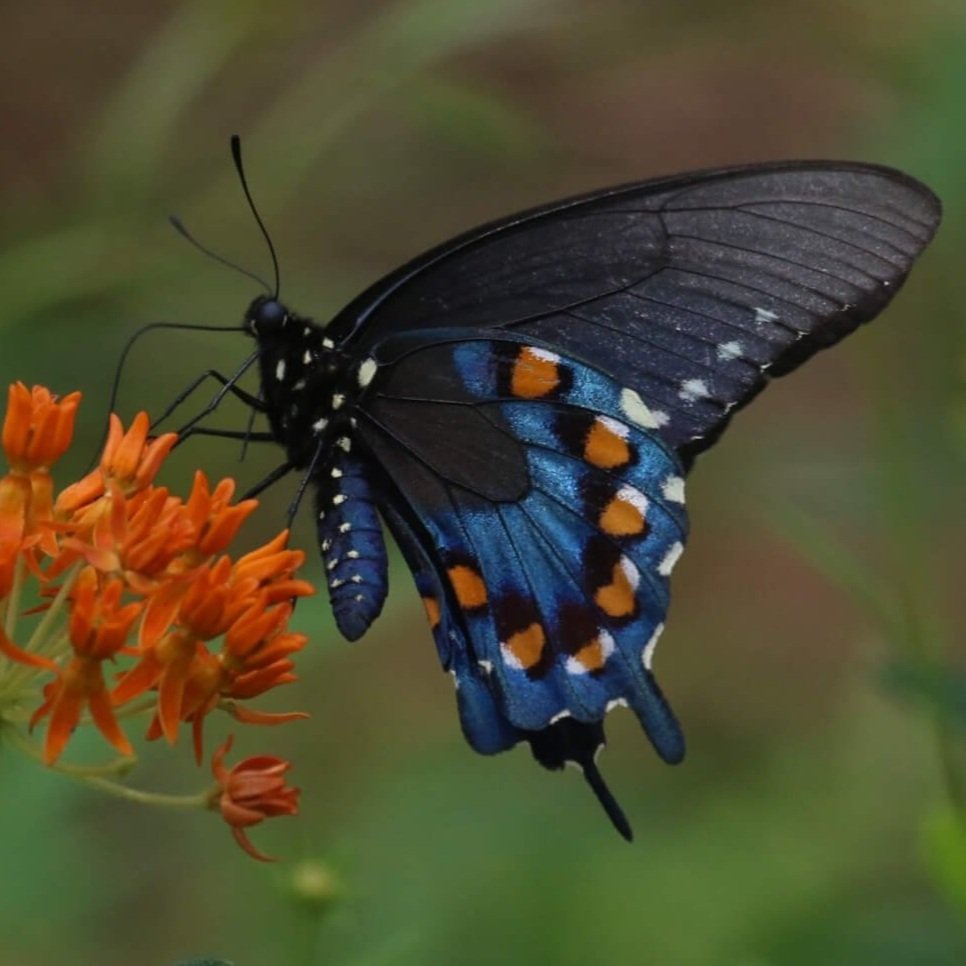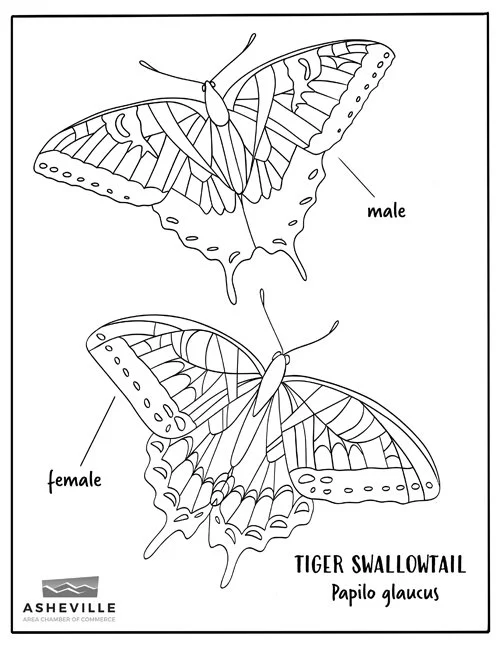
Eastern Tiger Swallowtail
Papilio glaucus
Asheville Visitor Center at 36 Montford Ave, Asheville
Look for the vibrant yellow and black striped wings of the Eastern Tiger Swallowtail in front of the Asheville Area Chamber of Commerce and Visitor Center. Thanks to Dr. Matt Bertone, NC State University, for providing the photo for the giant wings!
Hosted & Sponsored By:

Meet the Butterfly
Eastern Tiger Swallowtail adults fly in Western North Carolina from March to October. It is one of the largest butterflies in the U.S. with an average wingspan of 4.5 inches (11.5 cm).
Big and bold, the Eastern Tiger Swallowtail is the state butterfly of North Carolina, Virginia, South Carolina, Georgia, Alabama, and Delaware.
Papilio glaucus Range Map

Easter Tiger Swallowtail adults drink nectar from a variety of flowers.
They fan their wings as they visit blooms, which makes them a prime pollinator of flame azalea (Rhododendron calendulaceum).
'Flame Azalea' Flower Close up (Great Smokey Mountains, NC) Stacy Hodes CC BY 4.0
As their wings flap against the long reproductive parts of the flame azalea, they transfer pollen between the anther and stigma. Voila! Wing pollination.
This male is nectaring on common milkweed. Notice his wings are almost all yellow and black.
Only a hint of blue.
Photo: Sharon Mammoser

Females have a distinctive iridescent blue dusting along the bottom of their hindwings.
Females have two different forms.
Some are primarily yellow and black, like males.
Photo: Sharon Mammoser

Other females take a dark form and mimic the Pipevine Swallowtail (Battus philenor).
Photo: Sharon Mammoser
Pipevine Swallowtail
Photo: Will Stuart
Eastern Tiger Swallowtail
This Batesian mimicry may trick predators into thinking the dark tiger swallowtail carries distasteful toxins from the pipevine plant.
Other swallowtails use this trick, including Black Swallowtails and Spicebush Swallowtails. You can distinguish a dark female tiger swallowtail by her…
Solid black body
Underside with a thin blue line and orange dots along edge
Upper side that may have faint tiger striping and the blue dusting has a scalloped black line through it.
Photo: Public domain
Another look-a-like at high elevations is the larger Appalachian Tiger Swallowtail (Papilio appalachiensis), pictured on the left. The size difference is especially noticeable when males of the two species are puddling, drinking mineral-rich water from damp soil.
Photo: Heather Rayburn
Eastern Tiger Swallowtail eggs are round and greenish. They’re laid singly on host plants and typically hatch in 4-10 days.
Photo: USFWS
Completing their life cycle takes about 2 months, with 2 generations/year in WNC.
Illustration: Lauren Gingery

Caterpillar Host Plants
-
Sweetbay Magnolia Tree
Magnolia virginiana
Photo: Hope Duckworth/CC BY 4.0/NC Plant Toolbox
-

Wild Black Cherry Tree
Prunus serotina
Photo: AndoShev/Pixabay
-

Tulip Poplar Tree
Liriodendron tulipifera
Photo: wal_172619/Pixabay

Masters of Defense
Tiger Swallowtail caterpillars have 5 ways to protect themselves.
1
Newly hatched larva spin silk and create a mat that causes the leaf to curl around them.
You can see the silk in this photo of an older caterpillar by Doug Tallamy.

2
Young caterpillars look like bird poop. Yuck! Caterpillars go through five instars, and the first three are variations on this unpalatable theme.
Photo: Doug Tallamy
3
Their outsized head and eyes make older caterpillars look like snakes! The following photos reveal the truth.
Photo: Seth Ausubel
4
They can make a quick escape by dropping from a thread of the silk they spin. (That “tongue” is their head!)
Photo: Doug Tallamy
Background Photo: Tulip poplar. Leaves with tongue-like stipules (Wake County,NC), Cathy Dewitt, CC BY 4.0
5
When threatened, swallowtail caterpillars have a surprise defense. They shoot out a bright orange osmeterium that adds to their snake disguise. This fleshy, false forked “tongue” exudes disgusting chemicals to deter insect predators while their real head protudes below.
Photos: Sam Jaffe and The Caterpillar Lab
Cryptic Chrysalis
Mature caterpillars turn dark brown and pupate. They often create a silk girdle to help them attach to a branch or rock.
Chrysalises are well-camouflaged in greenish brown to match the twigs and leaves nearby. Their patterns can even match the bark and lichen!
In fall, pupating Eastern Tiger Swallowtails will go dormant and overwinter.
They emerge as adults in spring and the cycle begins anew.
Photo: Eastern Tiger Swallowtail chrysalis by Judy Gallagher, CC BY 2.0, Wikimedia
Color Your Own Eastern Tiger Swallowtail Butterfly
Download a free coloring page by Nina Veteto below.
How You Can Help
Tiger Swallowtails are very adaptable with a wide range of host plants. They’re not threatened, but you can still help reverse decline by taking action:
Add caterpillar host plants like Sweetbay Magnolia, Wild Black Cherry, and Tulip Poplar.
Include flowers in your garden for nectaring adults.
Remove exotic invasive plants that displace native species.
Avoid pesticide use.
Leave the leaves and stems for overwintering chrysalises.
Create a "puddling station" in your garden by setting aside a patch of soil in a sunny area and keeping it moist, potentially adding a bit of manure or compost.
Learn more about Pollinator Gardening Principles and create a certified pollinator habitat in your yard.
Photos: Dark Eastern Tiger Swallowtail on Ninebark by Jamie Boggs. Yellow Eastern Tiger Swallowtail on Oakleaf Hydrangea by John Tyson.
Thank You
Many people and organizations made this Butterfly Trail possible. See the full list.
For the Tiger Swallowtail Butterfly, we’d like to give a special thanks to:
UNCA NEMA lab for their research and illustration support
Dr. Matt Bertone, Department of Entomology and Plant Pathology, NC State University for taking photos of their butterfly specimens for the freestanding wings
Asheville Chamber of Commerce for hosting the station
Amy Landers at Landers Creative for webpage design
Jill Jacobs at Spriggly’s Beescaping for interpretive sign design
And these incredible photographers:
Sharon Mammoser, NatureForMySoul.com
Heather Rayburn
Sam Jaffe, The Caterpillar Lab
Seth Ausubel
Will Stuart
Jamie Boggs
John Tyson



















